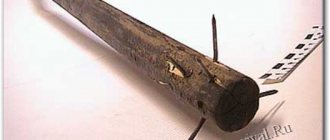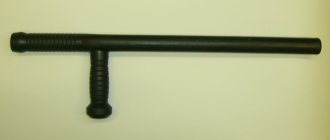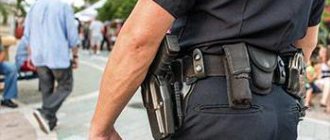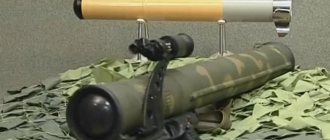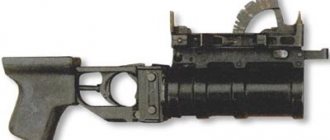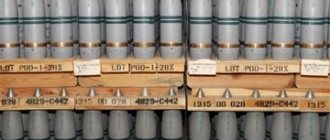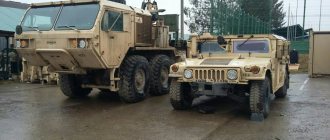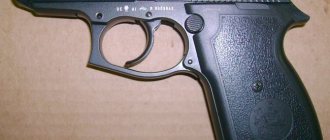Rubber stick
A rubber stick is a special tool designed for active defense, used in private security activities, and is included in the list of types of weapons of private security guards when repelling an attack that directly threatens the life and health of a security guard and (or) to suppress a criminal encroachment on protected property when the offender physical resistance. designed to strike the body of an offender in order to repel an attack or suppress the disobedience of an offender located at a distance of no more than 1.5 m. With its help, you can protect yourself from an armed attack, detain the offender, and deliver him to the police department. You cannot strike on the head, neck and clavicular area, abdomen, genitals, in the area of the projection of the heart, and also strike repeatedly in the same place.
What parts of the body can be hit with a rubber stick - Standard exercises for testing practical skills in the use of special means for security guards - Regulatory documents on electric shocks for private security companies in Russia.
Standards for ensuring private security. List of special equipment. Private security guard qualification exam. -Legislation
- Hands
- Hands
- Impact force
Do I need a permit for a telescopic baton?
of the Criminal Code of the Russian Federation, and for the seller, Article 222 of the Criminal Code of the Russian Federation. That is, the manufacture and sale of bladed weapons is a criminal offense. The owner of such a product (if the fact that the baton was manufactured by the owner himself is not established) faces a maximum fine under Article 20.
8 of the Code of Administrative Offenses of the Russian Federation (and then only due to seizure while wearing).
However, the use of a telescopic baton for self-defense, which was later recognized by an examination of cold steel weapons with impact-crushing action, will be an aggravating circumstance with all possible unpleasant consequences for the owner of the product.
Issue #32: Are expandable batons legal?
Attention The goal of self-defense is to stop, not to injure
- Knowing roughly how to throw backhand punches requires just a little practice.
- Know where to hit for maximum effectiveness. There are plenty of points - mostly joints and nerve nodes (hands, elbows, knees, shoulders, fingers, the notorious nine).
Hitting any such point will significantly reduce the mobility of the adversary without a global risk to his health.
As you can see, a telescopic baton is a faithful assistant, but there is one “but”. Remember the sentence: “Theoretically, telescopic batons are ideal?”
The key word in this sentence is “theoretically.” The fact is that in Ukraine, Russia and Belarus, these devices are considered chemical weapons and are prohibited from free sale and carrying.
Telescopic baton is prohibited or not
However, even in the best movies there are mistakes that the viewer can notice... Movies 14 ways cats show you their love There is no doubt that cats love us as much as we love them.
Important If you are not one of the people who favor this... Pets How to look younger: the best haircuts for those over 30, 40, 50, 60 Girls in their 20s do not worry about the shape and length of their hair. It seems that youth is created for experiments with appearance and daring curls
However, already after...
It seems that youth is created for experiments with appearance and daring curls. However, already after...
Telescopic baton - how legal is it?
What does the legislation say about this? Is a telescopic baton a weapon? There are a lot of types of weapons, and not all of them are listed in the legislation. But all objects that can be considered weapons have one thing in common: they are initially created with the purpose of hitting a living target.
And the telescopic baton is no exception. Its manufacturer emphasizes that such an item is easy to wear, because it is lightweight.
Telescopic baton for self-defense: banned or not in Russia
It should be borne in mind that the better and stronger the material, the more reliable the product will be and the longer the baton will last during use. Application Actively used as self-defense, as it helps limit the enemy’s combat effectiveness. It is enough to know several self-defense techniques using a baton to be able to disarm the enemy. And the very fact of surprise and surprise is the effectiveness of this weapon.
At the same time, it is quite difficult to kill a telescopic person, but serious injuries can be caused. This multifunctional design is actively used in the armed forces, police forces and other law enforcement agencies.
A hardened telescopic baton is almost a mandatory attribute of a professional as a means of self-defense.
Telescopic baton - confrontation between the law and one’s own safety
Tarasov, in my convex naval opinion, the TD is a special weapon, there were definitely such things in the explosives. In general, “good toys” are sold...sadly...Purely from forensics: TD can be recognized as an impact-crushing (non-blade) weapon.
The main feature of the design of such a weapon is the presence of a striking part, as well as its strength (you write that it is an alloy, most likely it is strong enough to inflict more than 25 blows). It can be compared with an ordinary leg from a strong stool; there are plenty of examples of this kind of murders .
Although the Criminal Code does not provide for liability for wearing such means, because We are talking about firearms, they can attract administrative charges, they will find an article... So throw this baton far away on the mezzanine and forget about it. I don’t recommend throwing it away, you never know who will use it.
Exam.
Standards for ensuring private security. List of special equipment.
Practical exercises.
Powerful civilian stun guns.
No permit or license required. Complies with the Weapons Law. March 30, 2007 The person being checked selects a ticket with the exercise number. Completing this exercise counts as successfully passing the test of practical skills in using special equipment. Exercise 1. “Using a protective helmet” The person being tested is located near a table with protective helmets of class 1 and 3.
At the command of the supervisor, “Put on a protective helmet of 1 (or 3) class,” the person being tested puts on a protective helmet of the specified class and reports: “I have finished the exercise.” The exercise time is 20 seconds.
Positive result: A protective helmet of the appropriate class is worn and fastened within the specified time.
Exercise 2. “Using a protective vest” The employee being inspected is located near a table with protective vests of grades 1 and 5.
At the command of the manager, “Put on a protective vest of class 1 (or 5),” the inspected employee puts on a protective vest of the specified class and reports: “I have finished the exercise.”
Device structure
An elastic and rather long baton is cast from rubber mass in a mold using vulcanization. Inside there is an embedded element that increases elasticity. The handle is quite rigid and dense, there are holes in it where a lanyard is inserted - a loop of nylon or leather one centimeter wide. The loop can be adjusted according to your hand.
To carry a rubber stick on a belt, there is a special device made of belts with a fastening ring.
The video below shows the use of a rubber stick PR 73, which received positive reviews from employees of the Ministry of Internal Affairs:
Using a rubber truncheon in private security work
The Law “On Private Detective and Security Activities in the Russian Federation” contains an article that gives private detectives and security guards the right to use a rubber truncheon in the following cases:
- to suppress a crime against the property they protect when the offender offers physical resistance.
- to repel an attack that directly threatens their life and health;
(It is prohibited to use special means against women with visible signs of pregnancy, persons with obvious signs of disability and minors, when their age is obvious or known to a private detective (security guard), except in cases of armed resistance, a group or other attack that threatens life and health private detective (security guard) or protected property.
Decree of the Government of the Russian Federation of February 3, 2010
N 47 Moscow “On approval of the Rules for storing, carrying and using special equipment by officials exercising state forest control and supervision”
In accordance with Article 96 of the Forest Code of the Russian Federation, the Government of the Russian Federation decides: To approve the attached Rules for the storage, carrying and use of special equipment by officials exercising state forest control and supervision. Chairman of the Government of the Russian Federation V.
Putin Rules for storing, carrying and using special equipment by officials exercising state forest control and supervision 1.
These Rules determine the procedure for storing, carrying and using special equipment by officials exercising state forest control and supervision (hereinafter referred to as officials). 2. Officials, when performing their duties to implement state forest control and supervision, may use as special means: rubber sticks; tear gas; handcuffs; means of forced stop of transport.
Previous page
At elevated ambient temperatures, the temperature of the armored space increases, which leads to increased sweating (dehydration of the body), increased body temperature, and deterioration of breathing. The time spent in body armor is reduced.
At lower ambient temperatures, the temperature of the armored space increases, which leads to the preservation of body temperature and improves the functioning of the organs of the human body. A bulletproof vest is like additional insulation for a person. In this regard, the time spent in body armor allows you to perform assigned tasks for a longer time. Nowadays, this problem has been largely solved.
In concealed body armor, special porous pads made from synthetic fibers are usually used for this purpose. They ensure air circulation between the vest and the body, as well as moisture removal from the body. Body armor for external wear often uses rectangular slats made of porous material, with gaps between them. Air circulation is ensured in these spaces.
Most often, in both cases, the ventilation system also acts as a shock absorber, forming the so-called shock-absorbing climatic support.
Body armor covers are made from ordinary fabrics used in the manufacture of everyday clothing. They are a vest that has pockets inside and/or outside for armor panels and, sometimes, external pockets designed to store various items. Since, with rare exceptions, the chest armor panel is made in one piece, the front of most body armor does not have a fastener. Fasteners are located on the sides and, sometimes, on the shoulders. Most often they are straps or wide belts sewn to the back of the cover and connected to the chest section using Velcro fasteners. The use of such fasteners allows you to quickly put on and take off a bulletproof vest; in addition, it ensures a simple adjustment of the bulletproof vest to a person’s body type. Thus, we can say that the body armor is not so comfortable to wear it just like that, but comfortable enough to wear it when necessary.
Long-term use of body armor depends not only on its protection and wearing comfort. One of the issues is the weight of the body armor.
The permissible time of continuous wearing of a bulletproof vest depends on several parameters, such as its thermal insulation and hygroscopic properties, ergonomic design, etc. The main parameter for body armor of 3 or more classes is its weight.
As a result of the conducted research, it was experimentally established that for an adult man with average physical characteristics, the time of continuous wearing of a bulletproof vest without deterioration of well-being under normal conditions, depending on the weight of the bulletproof vest, is:
- Body armor weight up to 7 kg - 12 hours
- Body armor weight up to 9 kg - 9 hours
- Body armor weight up to 12 kg - 5 hours
- Body armor weight up to 16 kg - 2 hours
- Body armor weight up to 23 kg - 1 hour
Of course, depending on the intensity of the work performed and environmental conditions, this time can vary significantly, both up and down.
The wearing time of light fabric body armor of protection classes 1 and 2, weighing up to 3 kg, depends mainly on their thermal insulation properties and the possibility of overheating the body. If used properly, it can last up to 24 hours or more. Question: Continuous wearing of a bulletproof vest (protective vest) for 12 hours (at a temperature of +18-22°C and humidity up to 60%) is allowed:
1. When the weight of the protective vest is from 9 to 12 kg. 2. When the weight of the protective vest is from 7 to 9 kg. 3. When the weight of the protective vest is up to 7 kg. 3
Question: How does the time of continuous wearing of a bulletproof vest (protective vest) change with increasing temperature and air humidity:
1. Decreases 2. Remains unchanged 3. Increases 1
Question: How does the time of continuous wearing of a bulletproof vest (protective vest) change when the air temperature drops:
1. Decreases 2. Remains unchanged 3. Increases 3
Preparing armor protection for use.
When preparing armor protection for use, it is necessary to check the presence and integrity of protective armor elements, the absence of cracks and damage visible to the naked eye on the surface of helmets and shields, and the absence of significant damage to fabric carriers.
Check the operation and reliability of fastening of the adjusting straps, fasteners and retention elements and use them to adjust them to the size of the employee or military personnel. Helmets are adjusted to the size of the head by adjusting the under-neck part or by re-lacing the fabric cover.
After using personal protective equipment, they must be inspected and undergo routine maintenance. Accounting, issuance and acceptance of personal protective equipment are carried out according to the accepted accounting and expenditure documents of the relevant services.
Handcuffs
Handcuffs: metal rings connected by a chain, put on the hands of criminals, prisoners Ozhegov's Explanatory Dictionary Handcuffs are designed to limit the physical ability of the arrested person to resist or commit an unlawful act.
Classic handcuffs consist of two metal bracelets connected by two welded chain links. The locking part of the handcuffs allows you to latch them without using a key, as well as to secure the latch from further unnecessary and even dangerous squeezing.
BR handcuffs are intended for use by private security guards to limit the physical ability of individuals to commit unlawful acts.
The product must be used in the climatic factors of the external environment described in GOST 15150-89 production 0 categories 1.1
General technical data and characteristics a) Breaking force, no less than 150 kg b) Working cycles, no less than 5000 times c) Dimensions, mm 249x86x13 d) Weight, no more than 0.5 kg The delivery set includes: a) product; b) product passport; c) key.
The product consists of two ring gripping mechanisms connected by a welded chain, which ends in a rotating earring mounted in the gripping mechanism. A key is supplied with the product.
The size of the handcuffs allows them to be used on any hand (we are talking about adults!), because... in the extreme position, the arms are compressed into an oval with sides of 5 and 4.5 cm, but they can also be snapped onto large enough wrists or even on the ankle
The metal bracelet is made in the form of two half-brackets rotating on an axis. One of the half-brackets has a locking device, the other has teeth (engaging with the locking device). Locking devices, despite their different designs, provide three positions: initial, fixed and open. In the initial position, the semi-clip with teeth can be engaged with the locking device and moved forward (reducing the circumference) to the required bracelet size.
In a fixed position, the semi-clip with teeth is in rigid engagement (at the required bracelet size) with the locking device.
To fix the sector in an engaged position with the locking device, it is necessary to push the pusher into the locking device with the tail of the key.
In the open position, the semi-claw with teeth can move back and forth in the locking device. The locking device is located in the half-bracket body. It consists of a specially shaped bracket with teeth, a “clamp-pusher” and a spring. The spring, put on the axle, acts on the bracket, lifting it up until it stops with the protrusion into the body and onto the “lock-pusher”, excluding its spontaneous movement (forward, backward). When turning the key in the locking device, the “latch-pusher” can be in the middle (the initial position of the locking device), moved forward (fixed position - the bracket is rigidly fixed, at the bottom by the “latch-pusher”, at the top by the housing protrusion) and moved back (open - “ the heel of the “lock-push”, resting against the “shoulder” of the bracket, lowers its teeth down).
Before using handcuffs, the locking devices must be in their original position. Preparing handcuffs for putting on means that the sector is engaged with the locking device and installed on the last prong. The locking device must be in the unlocked position (the pusher is not recessed).
Before handcuffing, the opponent's hand must be brought into a comfortable position (free the wrist). To put on handcuffs, it is necessary to hold the locking device, apply the sector to the wrist and sharply press the locking device so that the sector rotates 180 degrees on its axis and enters the locking device. Then it is necessary to squeeze the sector in the direction of movement so tightly as to exclude the possibility of removing the hand and excessive compression of the wrist, leading to cessation of blood circulation.
Having put on the handcuffs and set the required size (the bracelet should tightly cover the hand without disturbing the blood circulation of the hands), the locking devices are moved to a fixed position. To do this: in BR handcuffs, insert the key into the locking device and turn it clockwise; in BR-S handcuffs, the pusher is recessed with the tail part of the key.
To remove handcuffs, the locking devices are moved to the open position using a key. In BR handcuffs, the key is turned counterclockwise twice and, holding it in this position, the semi-claw with teeth is disengaged from the locking device. In BR-S handcuffs, turn the key first counterclockwise (remove it from locking), and then clockwise. Also, holding the key in this position, the semi-bracket is disengaged from the locking device.
Maintenance consists of carrying out flushing operations (with gasoline, white spirit, kerosene) and lubrication of the locking device every six months. If any elements of handcuffs fail, they are excluded from operational use and are not restored.
Types of handcuffs
BKS-1 “Tenderness-1” (special guard handcuffs with a connecting chain) are widely used among law enforcement officers and non-state (private) security companies.
Question: Which model of handcuffs, among those permitted in private security, uses a connecting chain?
1. BR-2M 2. BOS 3. BKS-1 3
BOS Tenderness-2" special operational handcuffs. Instead of a chain, the halves of the handcuffs are connected by three metal earrings, which only allow them to turn (fold) a little, which provides a more rigid fixation of the hands and does not make it possible, for example, to get into a pocket located on the other side of the cuffed hands. They have anti-squeeze pins and a groove on the arc. They have a lock that allows you to block further movement of the arc and prevent possible over-tightening. The latch is activated by pressing the pin on the side with a specially designed pin on the key.
Question: Which model of handcuffs used in private security activities has a rigid system for fastening the bracelets to each other?
1. BR-S 2. BOS 3. BKS-1 2
“BR-S” is the main model of handcuffs used by law enforcement officers and non-state (private) security companies.
"BR2-M" is a simplified version. There is no anti-spin or lock. The latch is similar to the “Tenderness-1” mechanism. The smallest in size among the chain ones. The secrecy of the castle leaves much to be desired, because... there is no pin that prevents access to the lock mechanism, the keyhole is made much larger than it should be. A key hole is made on the opposite cheek, which also causes a decrease in secrecy.
BR-S2 “Crab” Large size handcuff arms. Due to the large teeth on the closing arc, there is only one tooth on the mechanism latch. The latch protrudes outward, which allows them to be fixed without using a key, unlike many other models. The anti-squeeze groove is made only on one side of the arc. The key is bent from a flat metal plate. Unlike other fixed models, the locking is removed when the key is turned in the same direction as for opening.
BKS-1 "Prikol" - handcuffs with a stationary fastening.
Question: Which model of handcuffs used in private security activities has a manufacturing option designed for permanent fastening to the walls of buildings?
1. BR-S 2. BOS 3. BKS-1 3
How to prepare handcuffs for use a) Before use, check that the product is in working order as follows:
- make sure that sector 2 rotates freely
- drown sector 2 in the capture mechanism
- With the back of the key, push in the lock 5 of the inner part of the mechanism 1 grip (double locking of the mechanism)
- insert the key into the keyhole and turn it counterclockwise (this action will unlock the mechanism and pull out the latch),
- turn key 4 clockwise until it stops and, holding it, release sector 2 from the gripping mechanism.
b) the gripping mechanism should work and open without effort.
- Use of handcuffs:
a) Before use, the product must be in its initial state: sector 2 is in the gripping mechanism 1, the mechanism is not blocked by the latch (latch 5 is not recessed) b) After putting it on your hand, push sector 2 into the gripping mechanism 1. Be careful not to squeeze your hand tightly so as not to stop blood circulation. When checking the fixation of the handcuff locks, the hand (at the place where the handcuffs are secured) should be able to rotate without difficulty in the tightly fastened handcuffs.
Question: How is the fixation of handcuff locks checked so that it does not threaten the offender’s normal blood circulation?
1. Visual inspection of the offender’s limbs for blueness 2. Periodic opening and closing of the handcuff lock 3. Checking the ability of the handcuff bracelets to rotate without difficulty on the offender’s limbs 3
c) To prevent the opening of the gripping mechanism by foreign objects, press the lock 5 with the back of the key. d) To release, install the key in the keyhole and turn it counterclockwise (this action will unlock the mechanism - pull out the latch), turn key 4 clockwise until it stops and while holding it, release sector 2 from gripping mechanism 1. Maintenance is performed to check technical condition of the product and identify defects. The gripper mechanism must be lubricated at least four times a year.
Question: Cleaning and lubricating of handcuffs used in private security activities is carried out:
1. According to the instructions of the manufacturer 2. In the manner established by the relevant decree of the Government of the Russian Federation 3. Arbitrarily, by decision of the security guard 1
Ensuring the technical condition of handcuffs largely depends on the oil used to lubricate the working mechanism. Mineral or synthetic types of oils are used to lubricate the working mechanism of handcuffs. Mineral oils can be:
- based on naphthenes;
- based on paraffins;
- on mixed components (naphthenes and paraffins).
The oil has the following main characteristics: Viscosity. The viscosity of an oil is determined by its internal friction, or in other words, the resistance to oil flow. The higher the viscosity, the greater the resistance to flow. In the case of a high oil viscosity, the sliding time of the hemispheres increases, which causes increased wear of the friction surfaces.
However, if the oil viscosity is too low, this will negatively affect the operation of the gears, since in this case the oil film between the contacting surfaces becomes less durable and can be destroyed with minor contact forces. The destruction of the oil film will lead to direct interaction of the contacting surfaces and, as a consequence, the appearance of scoring. In addition, a lower viscosity value increases internal and external oil leaks. Viscosity is determined primarily by the wax content of crude oil.
Oil viscosity is highly dependent on temperature. It increases at low temperatures and decreases when heated. The solubility of wax contained in mineral types of oil decreases with decreasing temperature; under certain conditions, some of the wax may precipitate out of the oil.
Almost all lubricants contain some amount of mineral acids, which increase the aggressiveness of the environment. The oil should remain neutral as much as possible even in their presence.
The color of the oil is an indicator of the degree of its refining: oil that is too light (watery) indicates its excessive refinement with reduced lubricating characteristics, on the contrary, too dark a color indicates a lack of refinement of the oil, which corresponds to a high content of unsaturated hydrocarbon compounds. The oil must be refined to such an extent as to eliminate the content of unsaturated hydrocarbon compounds while maintaining lubricating characteristics. A good oil should be light in color, but not white and watery.
Polyester oil types are synthetic lubricants. Unlike mineral oils, polyester oils do not contain wax.
Based on the GOST requirements for oils used for rubbing surfaces not located in aggressive zones, the viscosity of the oil must be maintained within the temperature range from -30°C to +40°C. Therefore, based on the viscosity of the lubricant used to service the gripping mechanism, handcuffs can only be used within permissible temperatures, since exceeding the temperature limits causes damage to the product.
Question: What is the permissible operating temperature for handcuffs used in private security activities, ensuring their proper technical condition (serviceability)?
1. From -20°С to +30°С 2. From -30°С to +40°С 3. From -40°С to +50°С 2
If any part of the product is found to be defective, you must stop using it. The product cannot be restored.
Conditions of transportation and storage a) the product can be transported by any type of transport. b) the product must be stored in packaging indoors with an air temperature from +5 C to +40 C and a relative humidity of no more than 80%.
The manufacturer's warranty indicates that the product meets its specifications, subject to proper storage, maintenance and use. The warranty period is 18 months from the date of sale.
The domestically produced rubber stick is a special means of self-defense used in private security activities, and is included in the list of types of weapons of private security guards; it should be used only in cases of necessity, when other techniques are ineffective. With its help, you can protect yourself from an armed attack, detain offenders, and deliver them to the police station. The rubber stick is designed to strike various places of the offender, in order to repel an attack or suppress the disobedience of the offender, located at a distance of no more than 1.5 m.
A rubber stick is a cast rubber rod of round cross-section, ending at one end with a hemisphere and at the other with a handle with a lanyard. Some rubber poles have an additional perpendicular handle. On rubber sticks PR-73M, PR-K, there is a ring protrusion on the handle (mini-guard), to improve control with the stick when striking, and also protects the fingers when a glancing blow is struck by any enemy object on the stick. In addition, the protrusion serves as a stop for carrying a rubber stick in a hard case or ring near the belt.
The product is made from a rubber mixture by vulcanization in a mold. Elasticity in the transverse direction is provided by an embedded elastic element 380 mm long. The lanyard is made of leather, 10-12 cm wide.
In accordance with the Decree of the Government of the Russian Federation of August 14, 1992 No. 587 “Issues of private detective and security activities”, a list of rubber sticks used in non-state (private) security and non-state (private) detective activities is defined: Rubber stick of domestic production “PR” -73M", "PR-K", "PR-T", "PUS-1", "PUS-2", "PUS-3".
PUS-1 “Argument” is a special universal straight stick, 480 or 650 mm long. PUS-2 “Argument-M”/”Argument-B” is a special universal stick with an additional handle, 480 or 650 mm long. PUS-3 is a universal rubber telescopic stick (working length – 480 mm, folded length 300 mm). PUS-3 - folding (working length - 600 mm, folded - 300 mm)
Question: Which of the rubber sticks, approved for use in private security activities, has the greatest weight (850 g):
1. PR-K 2. PR-T 3. PR-73M 3
Question: Which of the rubber sticks, approved for use in private security activities, have the greatest length (650 mm):
1. PUS-1 and PUS-2 2. PR-T and PR-K 3. PUS-3 1
Question: Rubber sticks approved for use in private security activities have a diameter of:
1. From 30 to 32 mm. 2. From 34 to 36 mm. 3. From 38 to 40 mm. 1
Question: Which of the rubber sticks, approved for use in private security activities, is available in the “telescopic” version:
1. PUS-2 2. PR-T 3. PUS-3 3
Question: Rubber stick PUS-3, approved for use in private security activities, is available in the following versions:
1. Folding and telescopic 2. Straight and with side handle 3. Free and regular 1
Question: The rubber stick PR-73M, approved for use in private security activities, has in its design:
1. Protruding ring element (mini-guard) of the handle 2. Side handle 3. Metal tip 1
Question: Rubber sticks PUS-2 and PR-T, approved for use in private security activities, have in their design:
1. Protruding ring element (mini-guard) of the handle 2. Side handle 3. Metal tip 2
Basics of using special means depending on their type and type.
The legal basis for the use of special means by private security guards is the Law of the Russian Federation “On private detective and security activities in the Russian Federation”, other laws and legal acts of the Russian Federation, the Rules determined by the Decree of the Government of the Russian Federation of August 14, 1992 N 587 “Issues of non-state ( private) security and non-state (private) detective activities.”
Special means are used by private security guards in cases where non-violent methods of preventive influence on offenders have been used and have not produced the desired results to repel an attack while protecting the life and health of protected citizens and to suppress a crime against the property they protect when the offender offers physical resistance. The right to use special means is granted to private security guards who have undergone appropriate training and passed an annual test by the internal affairs bodies for professional suitability to act in situations involving their use. Illegal use of special means entails liability established by law.
The right to use special means by a private security guard:
1. While the security guard is performing his professional duties. 2. When issuing special equipment to a security guard for purposes established by law, on the basis of an order from the head of the security company. 3. If the private security guard has a security guard ID.
Special means are used in compliance with:
1. The order of application (sequence) of special means. 2. Rules for the use of special means (taking into account prohibitions and restrictions on the use of special means). 3. The grounds for using a rubber truncheon (a brief description in the law of the situation, faced with which in reality, a conclusion is drawn about the existence of the right to use special means.
The use of special means must be preceded by a warning about the intention to use them and sufficient time provided to comply with the requirements of the private security guard, except in cases where delay in using handcuffs creates an immediate danger to their life and health or may entail other serious consequences.
In situations where the use of special means is unavoidable, a private security guard is obliged to exercise restraint, act based on the prevailing situation and the goal that must be achieved, minimizing the possibility of causing damage and bodily harm.
When using special means, it must be ensured that pre-medical assistance is provided to persons who have received bodily injuries, and that the incident is notified to health and internal affairs authorities as soon as possible.
It is prohibited to use special means against women with visible signs of pregnancy, persons with obvious signs of disability and minors when their age is obvious or known to the private security guard, except in cases of armed resistance, a group or other attack that threatens the life and health of the private security guard or the protected person. property.
Features of the use of handcuffs - periodic (at least once every two hours) check of the locking condition of the locks is required.
Peculiarities of using rubber sticks - do not hit the head, neck, clavicular area, stomach, genitals, heart area.
Defense techniques and combined techniques using a rubber stick
To protect against attack, the security officer must use the advantages that the presence of a rubber truncheon creates for him.
This advantage can be realized when performing swinging strikes, mainly to the limbs, in combination with movement that ensures maintaining a distance that does not allow the opponent to grab or strike with a hand, foot, or short objects, including a knife.
Defense against attack primarily includes pre-emptive strikes with a rubber stick - strikes that are sudden and anticipate the enemy’s attack.
Favorable situations for pre-emptive strikes are:
- when the enemy clearly intends to attack and does not expect an attack from the employee;
- when trying to take a weapon out of clothing or take a lying dangerous object (knife, stick, broken bottle, etc.);
- when the armed hand is in a position unfavorable for attack, for example, the hand when gripping a knife from the little finger or a stick in the lower position;
- on the backswing, etc.
Before a pre-emptive strike, it is advisable to carry out distracting actions: conducting negotiations that lull vigilance, distracting with a glance, shouting, etc. A preemptive strike must be performed primarily on the armed hand in order to knock out the weapon or disable the hand.
There is an opinion that the main way to protect against blows is a counter swing blow with a rubber stick on the striking limb or beating with a swing blow of a rubber stick. In this regard, it should be noted that the rubber stick has quite a large inertia, since it has significant mass and has elastic properties. Taking this into account, repelling strikes with a hand, including those armed with short and light objects, may be ineffective, since a strike with a stick will be made slower than with a hand.
Therefore, the main way to protect against attacks from an enemy, especially those armed with edged weapons and dangerous objects, is to escape in combination with a swing blow with a rubber stick on the armed hand in order to disable the hand or knock out the weapon, regardless of the phase of the attack and its position. The reliability of this method of defense will be determined by the level of training in movements and swing strikes. In situations where the attack is carried out from a fairly short distance and at high speed, the same methods of defense that are used by an unarmed employee can be used: hitting with the forearm or palm, grabbing, placing the hand or less vulnerable places in combination with moves, turns and deflections, protection from slopes and dives.
Previous page
Rubber sticks in security activities: types, applications, limitations
The carrying and use of rubber truncheons by private security service employees has become a common occurrence for us today. At the same time, not all Russian citizens have an accurate idea of the exact purpose of this special security equipment and its types.
Also, few people have detailed information about the possibilities of using rubber batons by security guards and police officers and the legislative framework that regulates this area.
Our article provides a detailed description of a rubber stick as a special security device.
Its main types and legal norms governing the use of a police baton are noted here. The review also describes some techniques for effectively using a rubber stick as a weapon of self-defense. All information is provided by employees who have professional training and extensive experience in the use of rubber sticks and tonfas when providing security services in Moscow, St. Petersburg and Krasnodar.
In what situations is it used?
The PR-73 rubber stick is used:
- In prisons and pre-trial detention centers. In order to prevent an attack, employees of the penitentiary system have the right to use this special means in relation to suspects, accused and convicted persons. Hitting with a rubber truncheon is legalized during mass riots and group violations of the regime by persons under investigation and convicts. The use of special means is allowed in cases of disobedience to correctional officers and attempts to escape.
- To prevent escape when escorting a detainee, suspect or convicted person.
- When the hostages are released.
- During the dispersal of protesters at unauthorized rallies.
- During the assault by law enforcement special forces on buildings and vehicles.
The advantage of rubber sticks is the absence of serious injuries on the human body after using this special equipment. This is possible in cases where the use of PR meets all the requirements established by law.
Rules for using a rubber stick
Contents: dated August 14, 1992
N 587 RULES FOR THE USE OF SPECIAL EQUIPMENT BY PRIVATE DETECTIVES AND GUARDS 1. The legal basis for the use of special equipment by private detectives and security guards is the Law of the Russian Federation
“On private detective and security activities in the Russian Federation”
, other laws and legal acts of the Russian Federation, these Rules. 2. Rubber truncheons, handcuffs, tear gas and other means provided for in the relevant list are used as special means.
3. Special means are used by private detectives and security guards in cases where non-violent methods of preventive influence on offenders are used and do not produce the desired results: a) to repel an attack that directly threatens their life and health; 4. Special means in accordance with paragraph 3 of these Rules may be used:
Prices and reviews
A baton of this model costs from 500 rubles and more, a case for wearing on a belt will cost from 250 rubles.
- The accessory serves well for self-defense. It is advisable to direct the blows (with a pull) to where the skin is exposed. This makes it more painful.
- Carrying a long baton with you is not very convenient, but in a car it can be very useful.
- Law enforcement officers quite often show interest in baton owners. The outcome may vary. Permission may be required.
Rubber stick PR 73F
How to pass testing for special equipment of a security guard of 4, 5, 6 categories
Testing a security guard's knowledge and application is one component of the security guard's periodic testing. Although many will say at first glance that it is not so difficult, but judging by surveys, 85% of security guards who were unable to pass the test the first time “fail” on this very thing.
Why is this happening? The reason is very simple.
When you answer theoretically, everything is simple here, it’s enough to know the correct answer. In testing for knowledge and use of special equipment, tickets are also used, but you have to answer practically and here the “marketing frequency” of the inspectors is turned on, who often each have their own interpretation of the correct execution of a practical question, which often differs from the interpretation of execution set out in. Another reason is the guard’s lack of knowledge of special equipment, who cannot, for example, distinguish from . Let’s consider these issues in more detail: In accordance with Appendix
Use of a rubber stick by a 4th category security guard
// The employee being checked is located near the table with class 1 and 3 protection helmets.
At the command of the manager, the worker being inspected puts a protective helmet of the specified class on the dummy and reports: “The protective helmet of class 1 (or 3) is on.” The exercise time is 20 seconds. Often, those who are called upon to maintain order themselves become the target of attack.
With the increase in crime, such cases have become more frequent in relation to employees of the police department and the penal system. To resist intruders, employees of security companies, the penitentiary system and the police are equipped with such an effective special tool as a stick.
The modern rubber model of this weapon, which today can often be seen in the hands of security and law enforcement agencies, has its own history dating back to 1881. The person being tested is 1.5 meters opposite the dummy.
What is tonfa?
The word "tonfa" or "toifa" is translated as "handle". The original tonfa was the handle of a hand mill, which was widely used in the households of Okinawans. The handle was easily removed and could be used for an alternative purpose. Kobudo masters quickly recognized the potential of the item and included the tonfa in the arsenal of traditional weapons. This is the Japanese version of the emergence of tonfa techniques in karate and kobudo. Probably, the Chinese will tell their story that tonfa, as a weapon, appeared much earlier in China, and then came to Okinawa. Be that as it may, the tonfa became one of the most common types of civilian weapons and was and is widely practiced in karate and kobudo schools.
There are many varieties of tonfa, but the basic design is a stick with a perpendicular handle.
The tonfa grip resembles the formation of a karate fist. The hand should be relaxed to allow free action, but still sufficiently collected to hold the object. At the moment of striking or blocking, the fist is clenched to secure the tonfa in the hand. To effectively manipulate an object, it is necessary to develop hand strength, which is also useful for practitioners of karate and other types of kobudo.
Use of special equipment by a security guard, category 4, rubber stick
// The person being tested is 1.5 meters opposite the dummy.
The rubber stick is suspended on a belt. At the inspector’s command: “Start the exercise!” the person being tested removes the rubber stick from the suspension and strikes the dummy (at least six) in various areas allowed for impact with the rubber stick.
After this, the person being tested reports: “The exercise has finished.” Time to perform the exercise: 20 seconds. When performing the exercise, blows must be applied in a fixed manner, without using excessive force that could damage the dummy. Positive result: performing at least six blows with a rubber stick on the dummy within the specified time , preventing blows from being applied to areas corresponding to areas of the human body that are not allowed to be impacted. Appendix No. 2 to the Regulations on the conduct of internal organs
Universal special equipment “Argument”
1. PUS-1. The product belongs to special universal rubber sticks. Polymer synthetic materials are used in production. A lanyard is attached to the grooved handle. In order to prevent hand injuries, the developers have included a plastic shield in the design of this rubber stick. This PR can be worn on the belt using a special belt ring.
- The product size is 66 cm.
- Diameter 32 mm.
- Ring diameter – 4 cm.
- Lanyard diameter – 8 mm.
2. PUS-2. This product is identical to the first model of the universal special tool. The difference is that the PUS-2 design has an additional handle, which allows the guard to deliver swinging blows to the hands and at the same time maintain a distance from the enemy, not giving him the opportunity to grab and strike.
- The length of the gun in the folded position is 48 cm.
- The unfolded stick measures 65 cm.
3. PUS-3. Special universal rubber stick. The characteristics of this product are identical to the previous two models. The differences are in size. The telescopic PUS-3 when folded has a length of 30 cm, and after unfolding it is 48 cm. Rubber tips for sticks are designed for delivering sudden and pre-emptive strikes.
Starting positions for wearing and using pr-73
Stick horizontally from front (back): the stick is held with both hands with a simple overhand grip, the hands are ready to make a pre-emptive block or strike in front of you by bending the stick and throwing the middle part of the stick towards the point of contact with the opponent.
The way to achieve such a grip is from the stick down position: the left hand grabs the stick near the right hand, slides along the stick to the place necessary for applying the technique. 3. Stick on the shoulder; the right hand holding the stick is bent at the elbow, the end of the stick is directed away from you, back and up. The elbow must be pressed to the body.
The hand is in a position convenient for an overhead strike. Strikes using a rubber stick can be varied. In this part we describe only the basic, basic strikes, having mastered which you can begin to study their various variations and combinations, performing strikes from different distances and using different grips and swings.
1. An overhead strike with a stick is performed from a fighting stance, the elbow is raised, the stick lies on the shoulder (raised up).
Technique for using a rubber stick (PR-73), page 2
\ f) to suppress an attempt by a suspect, accused or convicted person to cause harm to others. The increase in crime in the country has led to an increase in the number of attacks on police officers while on duty. Often, police officers cannot resist criminals and do not even know how to use special equipment.
The same problem exists for employees of the penitentiary system, who, due to the nature of their official activities, have to deal with a diverse contingent of convicts, whose actions are sometimes difficult to predict. The special tool PR-73 and its modifications can significantly increase the efficiency of the actions of police officers and the penitentiary system, especially in cases where the use of firearms is extremely undesirable. The rubber stick is an intermediate link between fighting techniques and firearms, as a last resort
Legal basis
The use of any weapon, even for the purpose of self-defense, is regulated by current legislation. Some types of self-defense means are permitted for use without a license, since they are not capable of causing significant harm to an opponent. Others require obtaining appropriate permits to store and carry, since they can be classified as bladed or firearms.
Do you need a license to carry a baton?
A telescopic baton for self-defense is a weapon with shock-crushing action. With sufficient impact force, such a design can cause a fracture, so its use is quite dangerous. Therefore, this type of weapon is prohibited for free use. It was classified as a bladed weapon, and therefore carrying a baton is equivalent to combat knives.
Consequences of use
It should be understood that self-defense may involve causing serious bodily harm. And folding batons in this case pose a particular danger. If such a weapon is detected, law enforcement officers may take the following actions:
- Give the owner a verbal warning. Such an outcome of the situation happens extremely rarely, since law enforcement officers should not leave the fact of identifying a bladed weapon without attention.
- Confiscate the baton with a verbal warning. This option is possible if the baton was simply transported and was not used for self-defense.
- Seize the weapon and issue an administrative fine. This happens if a person uses this means of self-defense in a street fight. Even if the fact of self-defense does not require proof, a law enforcement officer is obliged to take certain measures, following the letter of the law.
Thus, a person is subject to administrative liability for carrying a baton, and criminal liability for making and attempting to sell it. Despite this, a telescopic baton is quite often purchased for self-defense purposes, being a truly reliable tool. You can buy various types of these weapons on the black market.
Carrying a baton is administrative liability, manufacturing and attempting to sell is criminal.
Self-defense experts do not advise their students to joke with the law, offering a worthy alternative to a folding baton. We are talking about a cane belt, which is not considered by law as a bladed weapon and is a sports and tourist product, excellent for self-defense purposes.
When folded, this design can be worn over a waist belt or carried in the glove compartment of a car. At the same time, it only takes a couple of seconds for such a product to turn into a powerful cane, capable of becoming a formidable weapon against intruders at any moment.
It should be understood that using a baton in self-defense can lead to unintended consequences. A blow to the head can result in a fracture of the base of the skull and death. A blow to the body can cause rupture of internal organs and bleeding, and to the limbs - serious fractures.
If you decide to carry a baton with you, then you should know that its use requires certain training:
Physical. It is advisable to have basic combat skills, because an experienced enemy can simply disarm you, subsequently using your own weapon. Therefore, people who are weak and unsure of themselves should not seriously consider a baton as a means of self-defense. Psychological
Such a weapon instills in a person confidence in his own abilities, and therefore it is very important to soberly assess the situation, using a baton only as a last resort, when self-defense is truly justified. If you use a baton in response to an insult, you will move from the category of victim to the category of attacker
And if we take into account the aggravating circumstances, the consequences of such behavior can be very unfavorable.
How to use different types of clubs for self-defense?
» » Today, probably each of us has thought about the need to purchase a means of self-defense.
Their diversity allows you to choose exactly the option that suits your characteristics. All kinds of , , and others are available to the buyer.
Batons, having many advantages over similar products, are becoming increasingly popular. After all, it is with the help of a baton that you can resist an unexpected attack, as well as use it for its intended purpose when attacking animals.

